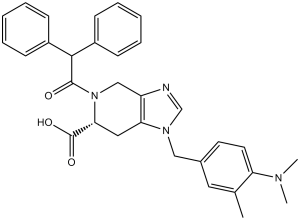PD 123319 [PD-123319; PD123319; (S)-(+)-PD 123319] is a novel, potent, and selective AT2 (angiotensin II) receptor antagonist with anti-hypertensive effects. It inhibits AT2 with an IC50 of 34 nM. It displaces 125I-labeled angiotensin II from a specific subset of angiotensin II binding sites in rat adrenal preparations. PD 123319 has been used to selectively examine the specific roles for AT1R and AT2R in hypertensive and other vascular research-related models. PD-123319 is found to prevent Ang II from binding the bovine zona glomerulosa microsomal preparation with IC50 value of 6.9nM in the binding assay using microsome.
Physicochemical Properties
| Molecular Formula | C31H32N4O3 | |
| Molecular Weight | 508.61 | |
| Exact Mass | 508.25 | |
| Elemental Analysis | C, 73.21; H, 6.34; N, 11.02; O, 9.44 | |
| CAS # | 130663-39-7 | |
| Related CAS # | PD 123319 ditrifluoroacetate;136676-91-0 | |
| PubChem CID | 5311345 | |
| Appearance | Solid powder | |
| Density | 1.2±0.1 g/cm3 | |
| Boiling Point | 775.8±60.0 °C at 760 mmHg | |
| Flash Point | 423.0±32.9 °C | |
| Vapour Pressure | 0.0±2.8 mmHg at 25°C | |
| Index of Refraction | 1.641 | |
| LogP | 4.4 | |
| Hydrogen Bond Donor Count | 1 | |
| Hydrogen Bond Acceptor Count | 5 | |
| Rotatable Bond Count | 7 | |
| Heavy Atom Count | 38 | |
| Complexity | 791 | |
| Defined Atom Stereocenter Count | 1 | |
| SMILES | O=C([C@@H]1CC2=C(N=CN2CC3=CC=C(N(C)C)C(C)=C3)CN1C(C(C4=CC=CC=C4)C5=CC=CC=C5)=O)O |
|
| InChi Key | YSTVFDAKLDMYCR-NDEPHWFRSA-N | |
| InChi Code | InChI=1S/C31H32N4O3/c1-21-16-22(14-15-26(21)33(2)3)18-34-20-32-25-19-35(28(31(37)38)17-27(25)34)30(36)29(23-10-6-4-7-11-23)24-12-8-5-9-13-24/h4-16,20,28-29H,17-19H2,1-3H3,(H,37,38)/t28-/m0/s1 | |
| Chemical Name | (6S)-1-[[4-(dimethylamino)-3-methylphenyl]methyl]-5-(2,2-diphenylacetyl)-6,7-dihydro-4H-imidazo[4,5-c]pyridine-6-carboxylic acid | |
| Synonyms |
|
|
| HS Tariff Code | 2934.99.9001 | |
| Storage |
Powder-20°C 3 years 4°C 2 years In solvent -80°C 6 months -20°C 1 month |
|
| Shipping Condition | Room temperature (This product is stable at ambient temperature for a few days during ordinary shipping and time spent in Customs) |
Biological Activity
| ln Vitro | It has been demonstrated that in a variety of tissues, PD 123319 can distinguish between two subclasses of AII receptors. Two kinds of binding sites for AII in a membrane preparation of bovine adrenal glomerulosa cells are selectively labeled by 125I-AII. With a strong affinity (IC50 of 92.9 nM) for DuP-753, the first class (DuP-753 sensitive) accounts for around 85% of all AII binding sites. Regarding 125I-AII binding to this location, PD-123319 has no effect. With an IC50 of 6.9 nM for PD-123319 and an IC50 of approximately 10 microM for DuP-753, the second class of binding sites exhibits greater sensitivity[2]. | ||
| ln Vivo |
|
||
| Animal Protocol |
|
||
| References |
[1]. Synthesis and structure-activity relationships of a novel series of non-peptide angiotensin II receptor binding inhibitors specific for the AT2 subtype. J Med Chem. 1991 Nov;34(11):3248-60. [2]. Modulation of angiotensin II binding affinity by allosteric interaction of polyvinyl sulfate with an intracellular domain of the DuP-753-sensitive angiotensin II receptor of bovine adrenal glomerulosa. Mol Pharmacol. 1992 Apr;41(4):809-15. [3]. No effect of angiotensin II AT(2)-receptor antagonist PD 123319 on cerebral blood flow autoregulation. J Renin Angiotensin Aldosterone Syst. 2001 Sep;2(3):188-92. [4]. Effects of intravenous PD 123319 on haemodynamic and arterial stiffness indices in healthy volunteers. J Renin Angiotensin Aldosterone Syst. 2005 Sep;6(2):102-6. |
||
| Additional Infomation | PD123319 is an imidazopyridine consisting of 4,5,6,7-tetrahydro-1H-imidazo[4,5-c]pyridine having 4-(dimethylamino)-3-methylbenzyl, diphenylacetyl and carboxy and groups at positions 1, 5 and 6 respectively It has a role as a vasoconstrictor agent, an endothelin receptor antagonist and an angiotensin receptor antagonist. |
Solubility Data
| Solubility (In Vitro) |
|
|||
| Solubility (In Vivo) |
|
| Preparing Stock Solutions | 1 mg | 5 mg | 10 mg | |
| 1 mM | 1.9661 mL | 9.8307 mL | 19.6614 mL | |
| 5 mM | 0.3932 mL | 1.9661 mL | 3.9323 mL | |
| 10 mM | 0.1966 mL | 0.9831 mL | 1.9661 mL |
